
1/29/2021
Things to Consider and FAQs When Planning to Purchase a Safe Room
Which is better, an underground shelter or an above-ground shelter?
Studies have shown that you are just as safe in an approved/certified above-ground safe room as in a
below-ground shelter. In certain situations you could actually be safer in an above-ground shelter,
such as when there is flooding or if the door is blocked by debris with no other way out.
Cons for below-ground shelters
•
Susceptible to stresses and strains of the ground freezing in the wintertime
•
Can be forced out of the ground in areas where the water table is high
•
Expensive to dig if bedrock exists
•
Possibility of flooding from rain, broken water pipes, or a high water table
•
Steep, narrow stairs for entry
Pros for above-ground shelters
•
Little or no ground preparation required
•
Can be entered easily, particularly by elderly or disabled
•
Less chance of flooding from rain or broken pipes
•
Less expensive to install in most cases
•
Can be conveniently located within the house or structure
What is a Safe Room vs. a Storm Shelter?
There is no law that requires manufacturers to test and certify their storm shelters. Buyer Beware!
There are many shelter manufacturers out there that are not certified. The buyer should always ask if
the manufacturer’s products have been approved and verified by the NSSA (National Storm Shelter
Association).
It is logical that debris impact testing would be more important for above-ground shelters, and ground
stress testing would be more important for below-ground shelters. Since most communities would
require a building permit for such a project, a family would have to have a building inspector examine
the plans for the shelter, and what building inspectors require would probably vary from community to
community perhaps even requiring the approval of a professional engineer. The Swisher ESP Safety
Shelter does qualify as a FEMA Safe Room based upon compliance with ICC 500
1
, FEMA P-361
2
, and
FEMA P-320
3
.
The ESP Safety Shelter passed all tests at Texas Tech National Wind Institute and underwent a
rigorous design analysis to withstand 250 mph winds from any direction as generated by an EF5
tornado.

怰
ҡ
1/29/2021
What is the NSSA?
The National Storm Shelter Association (NSSA) grew out of concern for storm shelter quality after the
Oklahoma City tornadoes of May 1999. The concept of an above-ground storm shelter, called an in-
residence shelter had been introduced in the Civil Engineer Magazine 25 years earlier.
Redevelopment of the shelter concept led Federal Emergency Management Agency (FEMA) to publish
FEMA P-320
3
, Taking Shelter from the Storm: Building a Safe Room for Your Home or Small Business.
The NSSA was formed in 2001 to ensure the highest quality of manufactured and constructed storm
shelters for protecting people form injury or loss of like from the effects of tornadoes, hurricanes, and
other devastating natural disasters.
Members of the NSSA have subjected their products to rigorous testing and evaluation to ensure the
highest quality products and safety. They have met or exceeded stringent quality requirements and
pledged sound business practices. Hence, you may confidently do business with NSSA members.

怰
ҡ
1/29/2021
What does NSSA offer you? To a shelter consumer, NSSA offers:
1. Identity of shelter producers who provide quality-verified products
2. Labels on quality-verified products to recognize quality
3. ICC/NSSA standard
1
that establishes quality criteria
4. Information and education via seminars, web pages, and responses to inquiries
5. Checklists of important elements of shelter quality
6. Advocacy for incentive programs for shelter construction
Is there FEMA funding available?
To determine if FEMA funding is available in your area, contact your local, county, or state emergency
management agency. Please keep in mind that all funding opportunities that we have been aware of
are not “paid up front” programs, but rebates. You must first purchase/install a shelter and have it
inspected. Then once all the paperwork required by your state (and local jurisdiction) has been
completed, you will receive a rebate. The amount varies by state, jurisdiction, and the amount of
funding available overall. Some states also require you to attend training sessions where you will learn
how to properly follow the process. This process can take months, and many states have deadlines to
get started. Again, check with your state’s emergency management agency for details.
After major tornado outbreaks, FEMA may release funding to cover a portion of the cost of a residential
Safe Room. To be eligible for a $2,000 rebate (under FEMA’s Project Impact, designed to help victims
rebuild after natural disasters), the product must be compliant with the requirements for a Safe Room
under FEMA P-361
2
and FEMA P-320
3
. Shelter manufacturers may or may not have this done, as it
can cost thousands of dollars, and it may even require extensive reworking of material or design
elements in the structure. The ESP Safety Shelter does qualify as a Safe Room under FEMA P-361
2
and is verified by the NSSA as being such.
FEMA criteria:
FEMA oversees and coordinates disaster relief, provides remediation funding after disasters, sets
recommended safety/design criteria for Safe Rooms, and studies the effects of natural disasters.
The FEMA criteria for storm shelters includes wind loads and debris impact. It is a goal that shelter
manufacturers should design for, but it is certainly more relevant for above-ground shelters than
underground shelters.
Keep in mind that there are always businesses that rush in after a disaster to take advantage of
victims. After Hurricane Andrew struck southern Florida, trucks crammed with jugs of tap water pulled
into town, charging exorbitant prices for something that was not considered valuable a day or two
earlier. After an ice storm struck Quebec, Canada in January 1998, one person bought a whole truck-
load of generators, then tried to peddle them to powerless Canadians at twice the price. There are also
companies that have products that can be “turned into” storm shelters. They have jumped into the
shelter business, adapting these products somewhat. So go by the old adage, “Let the buyer beware!”

怰
ҡ
1/29/2021
If you have already decided that you are going to buy a shelter, ask the hard questions before you
invest, because it really is an investment and your life could depend on it.
What is the safest shelter you offer?
All of our shelters have been designed, engineered, professionally evaluated, and tested to surpass the
requirements needed to withstand an EF5 tornado. The discerning factor is the shelter size that makes
you feel the safest. Personal preference plays a huge role in the peace of mind all of our shelters
provide. In short, the shelter that has been quality-verified by the National Storm Shelter Association
(NSSA) is the safest choice. Since every shelter we offer exceeds the standards set by the NSSA/ICC
500
1
and FEMA P-361
2
, no one shelter size is safer than another. If you can decide which size shelter
is right for you and your family, our quality control program ensures that no matter your choice, your
safety and security will be paramount.
Do you offer financing?
Yes! We understand the number one obstacle to owning a safe room is cost. When it comes to the
safety and protection of your family, cost should be the least of your concerns. That is why we are
proud to offer affordable financing through Bread financing and PayPal Credit. Contact us today and
find out how we can make the purchase of America’s best Safe Room a reality for your family.
What is the best location for my shelter?
Tornadoes typically track southwest to northeast, however, when viewing the devastation and debris
left behind, we can only be certain of one conclusion: Tornadoes are unpredictable and outside our
control. What we can control in these life threatening events, is how quickly we can get to our Safe
Room. The best spot for your shelter is one that can be easily and safely accessed without being an
intrusion in your day to day life. We understand that you won’t need to use your Safe Room daily, but
when you do, the easier it is to access, the more likely it is that you will use it quickly and when needed.
What should I look for when I first start searching for a Safe Room?
The most important thing to look for is a company that has had their Safe Room’s quality verified by
NSSA for wind speeds generated by an EF5 tornado. Quality verification involves having the shelters
not only debris impact tested, but also a written structural wind engineer evaluation. The structural
wind engineer evaluation is not the same as a stamped engineered drawing. Any engineer can stamp
a drawing, but only an engineer specializing in wind engineering can provide a written structural third
party evaluation. The ESP Safety Shelter meets all of these criteria (debris testing, stamped
engineering design specifications, and engineering third party evaluation (peer review)).

怰
ҡ
1/29/2021
What type of warranty do you provide?
ESP Safety Shelters properly installed and registered come with a Lifetime Storm Damage
Replacement Benefit and a 5 Year Limited Warranty. See product owner’s manual for complete
replacement and warranty details.
As my family grows, can the ESP Safety Shelter be enlarged?
Yes it can. You can purchase additional Expansion Kits (PN 20206) that will increase the depth of your
shelter in 15” increments per kit. Please note that this additional construction will also require a new
inspection.
What kind of steel do you use in your tornado storm shelters?
ESP Shelters are made of 3/16” hot rolled A36 Steel. They have been tested at Texas Tech’s National
Wind Institute and proven to withstand 15 lb. 2x4’s at 100 mph. This is equivalent to a 250 mph
tornado wind force, per FEMA P-361
2
.
What size Safe Room should I buy?
The standards recommend 3-5 sq. ft. per person, and 10 sq. ft. per wheelchair occupant. Beyond that,
the length of time you will spend in your Safe Room can help in determining the overall size. Other
things to consider are if you would need extra space for locking up valuables or using for dry storage.
Model No.
Internal Dimensions
SqFt
Occupancy Occupancy
External Dimensions
(5Sqft/Person)
(3Sqft/Person)
Business Private
W" D" H" Family W" D" H"
SR84X039G
80 35 76 19.4
3 6 87 42 78
SR84X054G
80 50 76 27.8
5 9 87 57 78
SR84X084G
80 80 76 44.4
8 14 87 87 78
SR84X114G
80 110 76 61.1
12 20 87 117 78
SR84X144G
80 140 76 77.8
15 25 87 147 78
SR114X84G
110 80 76 61.1
12* 20* 117 87 78
*Reduce total occupancy by 3 for each wheelchair occupant.

怰
ҡ
1/29/2021
What type of concrete foundation is required for your shelter?
To obtain near absolute protection from 250 mph EF5 tornado winds, the ESP Safety Shelter should be
secured to an adequate concrete slab as outlined in your shelter’s installation manual. At a minimum,
a 5” thick slab of 2500 psi (min) concrete is required with reinforcing of #4s on 24” centers. In addition,
an overhang of concrete is required, depending on the shelter size (see installation manual for details).
Any deviation from these minimum requirements would require an independent evaluation performed
by a structural engineer.
How hard is it to install the ESP Safety Shelter? Can I do it myself or do I need to hire someone?
The ESP Safety Shelter is very easy to install with the help of one or two additional people. It takes
minimal tools and experience. However, you may also hire a professional contractor to do the work.
Some helpful hints on locating a contractor can be found inside the installation manual. No matter who
performs the installation, the inspection checklist sign off procedure recommended by NSSA is critical
in ensuring that the Safe Room provides near absolute protection during a high wind event.
1
ICC/NSSA Standard for the Design and Construction of Storm Shelters, ICC 500-2014
2
Safe Rooms for Tornadoes and Hurricanes: Guidance for Community and Residential Safe Rooms, FEMA P-361-2015 Third Edition
3
Taking Shelter from the Storm: Building a Safe Room for Your Home or Small Business, FEMA P-320-2014 Fourth Edition
-
 1
1
-
 2
2
-
 3
3
-
 4
4
-
 5
5
-
 6
6
Swisher SR84X054G Operating instructions
- Type
- Operating instructions
Ask a question and I''ll find the answer in the document
Finding information in a document is now easier with AI
Related papers
-
Swisher SR114X84G FAQ
-
Swisher SR84X039G User manual
-
Swisher SR84X144G Owner's manual
-
Swisher SR114X84G Owner's manual
-
Swisher SR114X84G User manual
-
Swisher SR84X039G Specification
-
Swisher SR84X144G User manual
-
Swisher SR114X84G User manual
-
Swisher SR84X144G Installation guide
-
Swisher SR114X84G Installation guide
Other documents
-
Lifetime Yard Vacuum 115 User manual
-
Survive-a-Storm Shelters SASAS04D User manual
-
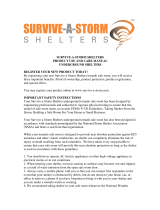 Survive-a-Storm Shelters SASGM0804 User manual
Survive-a-Storm Shelters SASGM0804 User manual
-
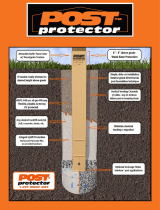 Post Protector 4442C12 Specification
Post Protector 4442C12 Specification
-
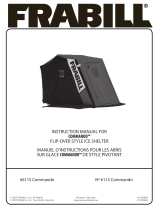 Frabill Commando 6115 User manual
Frabill Commando 6115 User manual
-
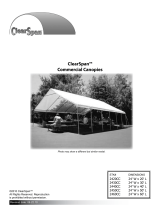 ClearSpan 2440CC User manual
ClearSpan 2440CC User manual
-
SICK SHELTER SOLUTIONS - CEMS, PGA, Liquid Analysis Systems Product information
-
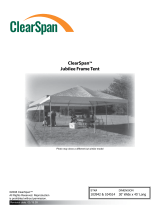 ClearSpan Jubilee Frame Tent Assembly Instructions Manual
ClearSpan Jubilee Frame Tent Assembly Instructions Manual
-
Tornado S15 Operation & Maintenance Manual
-
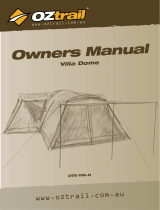 OZtrail Villa Dome Owner's manual
OZtrail Villa Dome Owner's manual











